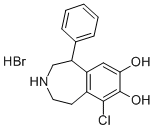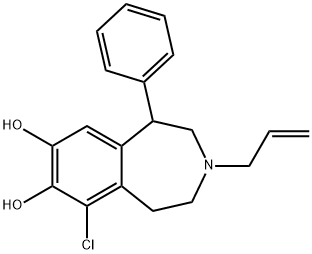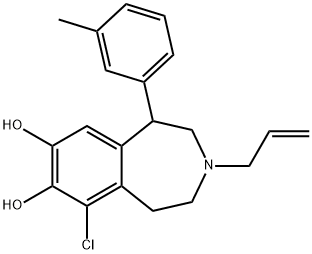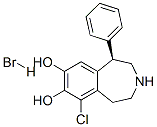(+/-)-6-CHLORO-7,8-DIHYDROXY-1-PHENYL-2,3,4,5-TETRAHYDRO-1H-3-BENZAZEPINE HYDROBROMIDE
Synonym(s):(±)-6-Chloro-7,8-dihydroxy-1-phenyl-2,3,4,5-tetrahydro-1H-3-benzazepine hydrobromide;(±)-SKF-81297 hydrobromide
- CAS NO.:71636-61-8
- Empirical Formula: C16H17BrClNO2
- Molecular Weight: 370.67
- MDL number: MFCD00153782
- SAFETY DATA SHEET (SDS)
- Update Date: 2024-11-19 23:02:33

What is (+/-)-6-CHLORO-7,8-DIHYDROXY-1-PHENYL-2,3,4,5-TETRAHYDRO-1H-3-BENZAZEPINE HYDROBROMIDE?
The Uses of (+/-)-6-CHLORO-7,8-DIHYDROXY-1-PHENYL-2,3,4,5-TETRAHYDRO-1H-3-BENZAZEPINE HYDROBROMIDE
(±)-6-Chloro-PB hydrobromide has been used as a dopamine D1 receptor (Drd1a) agonist to study the role of the drd1a-dopamine receptor inactivation of extracellular signal?regulated protein kinase 1/2 (ERK1/2) in the wild-type and striatum of dopamine-depleted mice. It has also been used as a Drd1a agonist to identify the contribution of D1 (D1R)-like dopamine receptor signaling on learning and memory in Barnes maze in rats.
What are the applications of Application
SKF 81297 hydrobromide is an agonist of the D1DR
Definition
ChEBI: 9-chloro-5-phenyl-2,3,4,5-tetrahydro-1H-3-benzazepine-7,8-diol is a benzazepine.
Biological Activity
Dopamine D 1 -like receptor agonist. Centrally active following systemic administration in vivo .
Biochem/physiol Actions
(+/-)-6-Chloro-PB HBr is a full D1 dopamine receptor agonist.
Properties of (+/-)-6-CHLORO-7,8-DIHYDROXY-1-PHENYL-2,3,4,5-TETRAHYDRO-1H-3-BENZAZEPINE HYDROBROMIDE
| storage temp. | Desiccate at +4°C |
| solubility | H2O: 1.7 mg/mL |
| form | solid |
| color | gray |
Safety information for (+/-)-6-CHLORO-7,8-DIHYDROXY-1-PHENYL-2,3,4,5-TETRAHYDRO-1H-3-BENZAZEPINE HYDROBROMIDE
| Signal word | Warning |
| Pictogram(s) |
 Exclamation Mark Irritant GHS07 |
| GHS Hazard Statements |
H315:Skin corrosion/irritation H319:Serious eye damage/eye irritation H335:Specific target organ toxicity, single exposure;Respiratory tract irritation |
| Precautionary Statement Codes |
P261:Avoid breathing dust/fume/gas/mist/vapours/spray. P264:Wash hands thoroughly after handling. P264:Wash skin thouroughly after handling. P271:Use only outdoors or in a well-ventilated area. P280:Wear protective gloves/protective clothing/eye protection/face protection. P302+P352:IF ON SKIN: wash with plenty of soap and water. P305+P351+P338:IF IN EYES: Rinse cautiously with water for several minutes. Remove contact lenses, if present and easy to do. Continuerinsing. |
Computed Descriptors for (+/-)-6-CHLORO-7,8-DIHYDROXY-1-PHENYL-2,3,4,5-TETRAHYDRO-1H-3-BENZAZEPINE HYDROBROMIDE
New Products
4-AMINO-TETRAHYDRO-PYRAN-4-CARBOXYLIC ACID HCL 4-(Dimethylamino)tetrahydro-2H-pyran-4-carbonitrile 4-Aminotetrahydropyran-4-carbonitrile Hydrochloride (R)-3-Aminobutanenitrile Hydrochloride 3-((Dimethylamino)methyl)-5-methylhexan-2-one oxalate 1,4-Dioxa-8-azaspiro[4.5]decane 5-Bromo-2-nitropyridine Nimesulide BP Aceclofenac IP/BP/EP Diclofenac Sodium IP/BP/EP/USP Mefenamic Acid IP/BP/EP/USP Ornidazole IP Diclofenac Potassium THOMAIND PAPER PH 2.0 TO 4.5 1 BOX BUFFER CAPSULE PH 9.2 - 10 CAP SODIUM CHLORIDE 0.1N CVS ALLOXAN MONOHYDRATE 98% PLATINUM 0.5% ON 3 MM ALUMINA PELLETS (TYPE 73) LITHIUM AAS SOLUTION 2-Bromo-1-(bromomethyl)-3-chloro-5-nitrobenzene 2-Bromo-3-nitroaniline N-(3-Hydroxypropyl)-N-methylacetamide 3-Bromo-6-chloropyridazine 4-ethyl-3-nitrobenzoic acidRelated products of tetrahydrofuran







You may like
-
 (±)-6-Chloro-PB hydrobromide CAS 71636-61-8View Details
(±)-6-Chloro-PB hydrobromide CAS 71636-61-8View Details
71636-61-8 -
 1-Methyl-6-oxo-1,6-dihydropyridazine-3-carbonitrile 98%View Details
1-Methyl-6-oxo-1,6-dihydropyridazine-3-carbonitrile 98%View Details
99903-60-3 -
 1823368-42-8 98%View Details
1823368-42-8 98%View Details
1823368-42-8 -
 2-(3-(tert-butyl)phenoxy)-2-methylpropanoic acid 1307449-08-6 98%View Details
2-(3-(tert-butyl)phenoxy)-2-methylpropanoic acid 1307449-08-6 98%View Details
1307449-08-6 -
 Ethyl 3-(furan-2-yl)-3-hydroxypropanoate 25408-95-1 98%View Details
Ethyl 3-(furan-2-yl)-3-hydroxypropanoate 25408-95-1 98%View Details
25408-95-1 -
 2-Chloro-5-fluoro-1-methoxy-3-methylbenzene 98%View Details
2-Chloro-5-fluoro-1-methoxy-3-methylbenzene 98%View Details
1805639-70-6 -
 1784294-80-9 98%View Details
1784294-80-9 98%View Details
1784294-80-9 -
 Lithium ClavulanateView Details
Lithium ClavulanateView Details
61177-44-4
Statement: All products displayed on this website are only used for non medical purposes such as industrial applications or scientific research, and cannot be used for clinical diagnosis or treatment of humans or animals. They are not medicinal or edible.